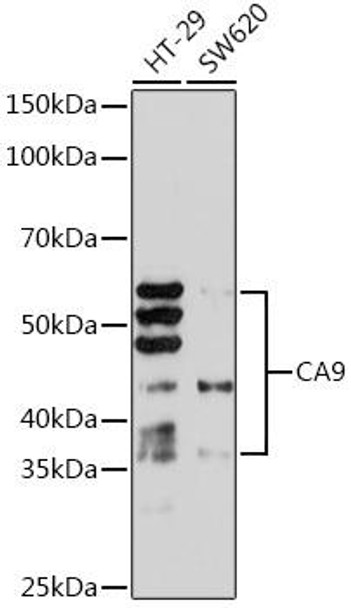Anti-CA9 Antibody (CAB4934)
- SKU:
- CAB4934
- Product type:
- Antibody
- Reactivity:
- Human
- Host Species:
- Rabbit
- Isotype:
- IgG
- Research Area:
- Cell Biology
Frequently bought together:
Description
| Antibody Name: | Anti-CA9 Antibody |
| Antibody SKU: | CAB4934 |
| Antibody Size: | 20uL, 50uL, 100uL |
| Application: | WB IHC |
| Reactivity: | Human |
| Host Species: | Rabbit |
| Immunogen: | A synthesized peptide derived from human CA9 |
| Application: | WB IHC |
| Recommended Dilution: | WB 1:500 - 1:2000 IHC 1:50 - 1:200 |
| Reactivity: | Human |
| Positive Samples: | HT-29, SW620 |
| Immunogen: | A synthesized peptide derived from human CA9 |
| Purification Method: | Affinity purification |
| Storage Buffer: | Store at -20°C. Avoid freeze / thaw cycles. Buffer: PBS with 0.02% sodium azide, 0.05% BSA, 50% glycerol, pH7.3. |
| Isotype: | IgG |
| Sequence: | Email for sequence |
| Gene ID: | 768 |
| Uniprot: | Q16790 |
| Cellular Location: | |
| Calculated MW: | 50kDa |
| Observed MW: | 35-58KDa |
| Synonyms: | CAIX, MN |
| Background: | Carbonic anhydrases (CAs) are a large family of zinc metalloenzymes that catalyze the reversible hydration of carbon dioxide. They participate in a variety of biological processes, including respiration, calcification, acid-base balance, bone resorption, and the formation of aqueous humor, cerebrospinal fluid, saliva, and gastric acid. They show extensive diversity in tissue distribution and in their subcellular localization. CA IX is a transmembrane protein and is one of only two tumor-associated carbonic anhydrase isoenzymes known. It is expressed in all clear-cell renal cell carcinoma, but is not detected in normal kidney or most other normal tissues. It may be involved in cell proliferation and transformation. This gene was mapped to 17q21.2 by fluorescence in situ hybridization, however, radiation hybrid mapping localized it to 9p13-p12. [provided by RefSeq, Jun 2014] |
| UniProt Protein Function: | CA9: Reversible hydration of carbon dioxide. Participates in pH regulation. May be involved in the control of cell proliferation and transformation. Appears to be a novel specific biomarker for a cervical neoplasia. Forms oligomers linked by disulfide bonds. By hypoxia. Expressed primarily in carcinoma cells lines. Expression is restricted to very few normal tissues and the most abundant expression is found in the epithelial cells of gastric mucosa. Inhibited by coumarins, saccharin, sulfonamide derivatives such as acetazolamide (AZA) and Foscarnet (phosphonoformate trisodium salt). Belongs to the alpha-carbonic anhydrase family. |
| UniProt Protein Details: | Protein type:EC 4.2.1.1; Nucleolus; Membrane protein, integral; Lyase; Energy Metabolism - nitrogen Chromosomal Location of Human Ortholog: 9p13.3 Cellular Component: microvillus membrane; basolateral plasma membrane; integral to membrane; nucleolus; plasma membrane Molecular Function:carbonate dehydratase activity; zinc ion binding Biological Process: response to drug; secretion; bicarbonate transport; morphogenesis of an epithelium; one-carbon compound metabolic process; response to testosterone stimulus |
| NCBI Summary: | Carbonic anhydrases (CAs) are a large family of zinc metalloenzymes that catalyze the reversible hydration of carbon dioxide. They participate in a variety of biological processes, including respiration, calcification, acid-base balance, bone resorption, and the formation of aqueous humor, cerebrospinal fluid, saliva, and gastric acid. They show extensive diversity in tissue distribution and in their subcellular localization. CA IX is a transmembrane protein and the only tumor-associated carbonic anhydrase isoenzyme known. It is expressed in all clear-cell renal cell carcinoma, but is not detected in normal kidney or most other normal tissues. It may be involved in cell proliferation and transformation. This gene was mapped to 17q21.2 by fluorescence in situ hybridization, however, radiation hybrid mapping localized it to 9p13-p12. [provided by RefSeq, Jul 2008] |
| UniProt Code: | Q16790 |
| NCBI GenInfo Identifier: | 83300925 |
| NCBI Gene ID: | 768 |
| NCBI Accession: | Q16790.2 |
| UniProt Secondary Accession: | Q16790,Q5T4R1, |
| UniProt Related Accession: | Q16790 |
| Molecular Weight: | 49,698 Da |
| NCBI Full Name: | Carbonic anhydrase 9 |
| NCBI Synonym Full Names: | carbonic anhydrase IX |
| NCBI Official Symbol: | CA9 |
| NCBI Official Synonym Symbols: | MN; CAIX |
| NCBI Protein Information: | carbonic anhydrase 9; pMW1; CA-IX; P54/58N; OTTHUMP00000022773; membrane antigen MN; carbonic dehydratase; carbonate dehydratase IX; RCC-associated antigen G250; RCC-associated protein G250; renal cell carcinoma-associated antigen G250 |
| UniProt Protein Name: | Carbonic anhydrase 9 |
| UniProt Synonym Protein Names: | Carbonate dehydratase IX; Carbonic anhydrase IX; CA-IX; CAIX; Membrane antigen MN; P54/58N; Renal cell carcinoma-associated antigen G250; RCC-associated antigen G250; pMW1 |
| Protein Family: | Carbonic anhydrase |
| UniProt Gene Name: | CA9 |
| UniProt Entry Name: | CAH9_HUMAN |




